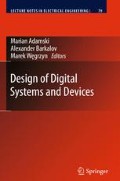Abstract
In this chapter, we will discuss how evolutionary methods can be used for test generation of digital circuits. In present time it is strongly investigated the new direction in theory and practice of artificial intelligence and information systems – evolutionary computations. This term is used to generic description of the search, optimizing or learning algorithms, based on some formal principles of natural evolutional selection, which are sufficiently applied in solving various problems of machine learning, data mining, databases etc [1]. Among this approaches following main paradigms can be picked out: genetic algorithms (GA), evolutionary strategy (ES), evolutional programming (EP), genetic programming (GP). The differences of these approaches mainly consist in the way of target solution representation and in different set of evolutional operators used in evolutional simulation. Classical GA uses the binary encoding of problem solution and basic genetic operators are crossover and mutation. In ES solution is represented by real numbers vector and basic operator is mutation. EP uses FSM as solution representation and mutation operator. In GP problem solution is represented by program, crossover and mutation operators are applied. Now this classification is enough relative and interaction of basic evolutionary paradigms each other takes place.
Access this chapter
Tax calculation will be finalised at checkout
Purchases are for personal use only
Preview
Unable to display preview. Download preview PDF.
References
Holland, J.P.: Adaptation in Natural and Artificial Systems. In: An Introductionary Analysis With Application to Biology? Control and Artificial Intelligence 210 (1975)
Goldberg, D.E.: Genetic Algorithms in Search, Optimization and Machine Learning. Addison-Wesley, Reading (1989)
Skobtsov, Y.A., Skobtsov, V.Y.: Modern modifications and generalizations for genetic algorithms. Tavrichesky Bulletin of Information Science and Mathematics 1, C60–C71 (2004) (in Russian)
Skobtsov, Y.A., Skobtsov, V.Y.: The logical simulation and testing of digital devices.-Donetsk:IAMM NASU 436 (2005) (in Russian )
O’Dare, M.J., Arslan, T.: Hierarchical test pattern generation using a genetic algorithm with a dynamic global reference table. In: First IEE/IEEE international Conference on – Genetic Algorithms in Engineering Systems: Innovations and Applications, vol. 414(12-14), pp. 517–523 (1995)
Becker, B., Keim, M.: Hybrid fault Simulation for Synchronous Sequential Circuits. Journal of Electronic Testing: Theory and Applications 15, 219–238 (1999)
Pomeranz, I., Reddy, S.M.: The multiple observation time strategy. IEEE Transactions on Computers 41(5), 627–637 (1992)
Prinetto, P., Rebaudengo, M., Sonza, R.M.: An Automatic Test Pattern Generator for Large Sequential Circuits based on Genetic Algorithms. In: Proc. Int. Test Conf., pp. 240–249 (1994)
Saab, D.G., Saab, Y.G., Abraham, J.: CRIS: A Test Cultivation Program for Sequential VLSI Circuits. In: Proc. Int. Conf. on Computer Aided Design, pp. 216–219 (1992)
Rudnick, E.M., Holm, J.G., Saab, D.G., Patel, J.H.: Application of Simple Genetic Algorithm to Sequential Circuit Test Generation. In: Proc. European Design & Test Conf., pp. 40–45 (1994)
Muzuder, P., Rudnic, E.M.: Genetic algorithms for VLSI design, layout & test automation, p. 336. Prentice Hall PTR, Englewood Cliffs (1999)
Hsiao, M.S., Rudnick, E.M., Patel, J.H.: Automatic test generation using genetically-engineered distinguishing sequences. In: Proc. IEEE Test Symp., pp. 216–223 (1996)
Prinetto, P., Rebaudengo, M., Sonza, R.M.: An Automatic Test Pattern Generator for Large Sequential Circuits based on Genetic Algorithms. In: Proc. Int. Test Conf., pp. 240–249 (1994)
Mahfoud, S.W.: A comparison of parallel and sequential niching methods. In: Proceedings of VI International Conference on Genetic Algorithms, pp. 136–143 (1995)
Corno, F., Prinetto, P., Rebauden, M., Sonza Reorda, M., Veiluva, E.: A PVM tool for automatic test generation on parallel and distributed systems. In: Proc. Int. Conf. on High-Performance Computing and Networking, pp. 39–44 (1995)
Krishnaswamy, D., Hsiao, M.S., Saxena, V., Rudnik, E.M., Patel, J.H.: Parallel genetic algorithms for simulation-based sequential circuit test-generation. In: IEEE VLSI Design Conf., pp. 475–481 (1997)
Abramovici, M.: Digital System Testing and Testable Design, vol. 652. Computer Science Press, New York (1990)
Hsiao, M.S., Rudnic, E.M., Patel, J.H.: Automatic test generation using genetically-engineered distinguishing sequences. In: Proc. VLSI Test. Symp., pp. 216–223 (1996)
Corno, F., Cumani, G., Sonza Reorda, M., Squillero, G.: Fully Automatic Test Program Generation for Microprocessor Cores. In: DATE 2003: Design, Automation and Test in Europe, Munich, Germany, pp. 1006–1011 (2003)
Author information
Authors and Affiliations
Editor information
Editors and Affiliations
Rights and permissions
Copyright information
© 2011 Springer-Verlag Berlin Heidelberg
About this chapter
Cite this chapter
Skobtsov, Y.A., Skobtsov, V.Y. (2011). 13 Evolutionary Test Generation Methods for Digital Devices. In: Adamski, M., Barkalov, A., Węgrzyn, M. (eds) Design of Digital Systems and Devices. Lecture Notes in Electrical Engineering, vol 79. Springer, Berlin, Heidelberg. https://doi.org/10.1007/978-3-642-17545-9_13
Download citation
DOI: https://doi.org/10.1007/978-3-642-17545-9_13
Publisher Name: Springer, Berlin, Heidelberg
Print ISBN: 978-3-642-17544-2
Online ISBN: 978-3-642-17545-9
eBook Packages: EngineeringEngineering (R0)

